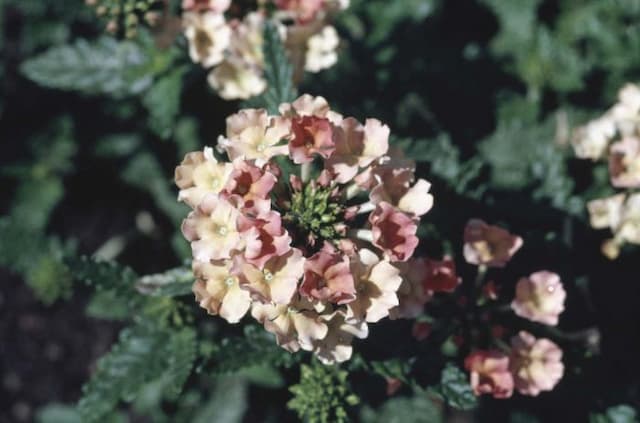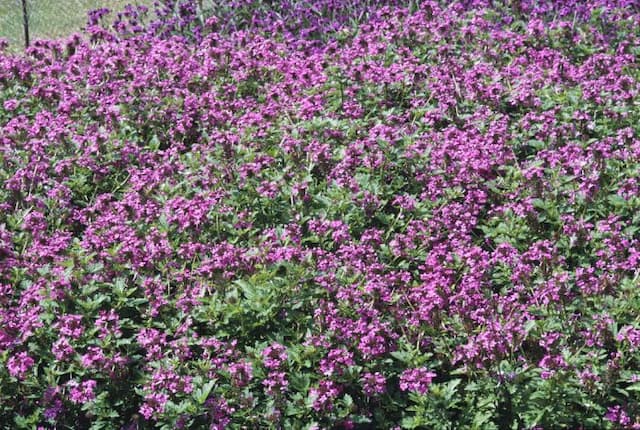Macdougall's Verbena Verbena macdougalii 'Lavender Spires'

ABOUT
Verbena macdougalii 'Lavender Spires' is a striking plant renowned for its vibrant floral displays and attractive foliage. The flowers of 'Lavender Spires' are perhaps its most captivating feature, presenting clusters of small, tubular blossoms that exude a soft lavender hue, forming elongated flower spikes that sway gracefully atop the stems. These spikes emerge in abundance and hold their color for an extended period, making them a focal point in any garden setting. The foliage of this variety of Verbena consists of deep green leaves with a textured and somewhat serrated edge, which provides the perfect backdrop for the delicate flowers. The leaves are lance-shaped, creating a lush, dense mound that stretches out around the plant base, contributing to the overall lush appearance of the plant. Overall, Verbena macdougalii 'Lavender Spires' exudes a sense of romantic charm and softness due to its soothing palette and cluster-like floral arrangement, which are visually pleasing and often attract butterflies and other pollinators to the garden. Its beauty lies not just in its blooms but also in its overall bushy and robust form, which allows it to blend harmoniously with other plants in a mixed border or stand out in a container garden.
About this plant
 Names
NamesFamily
Verbenaceae
Synonyms
Lavender Spires Verbena, Macdougal's Verbena, Highland Vervain
Common names
Verbena macdougalii 'Lavender Spires'.
 Toxicity
ToxicityTo humans
Verbena, including the variety Verbena macdougalii 'Lavender Spires', is not typically considered highly toxic to humans. However, some people may experience mild irritation or an allergic reaction if they have sensitivities, especially after handling the plant and then touching their face or eyes. Ingesting large quantities could potentially cause stomach upset and discomfort. It is always advisable to avoid eating any part of ornamental plants due to potential health risks and to keep them away from children who may inadvertently put plant material in their mouths.
To pets
Verbena is also not commonly considered highly toxic to pets. However, ingestion might cause mild gastrointestinal upset for some animals, such as vomiting or diarrhea. As with humans, pets with particular sensitivities might experience a more severe reaction. It is always best to prevent pets from eating plants, both indoors and out, to avoid any potential health issues. If you suspect your pet has eaten a large amount of verbena or is showing signs of distress, it is important to contact your veterinarian.
 Characteristics
CharacteristicsLife cycle
Perennials
Foliage type
Deciduous
Color of leaves
Green
Flower color
Lavender
Height
2-3 feet (60-91 cm)
Spread
2-3 feet (60-91 cm)
Plant type
Herb
Hardiness zones
7
Native area
North America
Benefits
 General Benefits
General Benefits- Attracts Pollinators: Verbena 'Lavender Spires' is known for attracting bees, butterflies, and other beneficial insects, thereby supporting local ecosystems.
- Drought Tolerant: Once established, this plant is relatively drought-resistant, making it suitable for xeriscaping and low-water gardens.
- Low Maintenance: Verbena 'Lavender Spires' generally requires minimal care, thriving in a variety of soil conditions and withstanding neglect.
- Long Blooming: Provides a long flowering season, usually from early summer to frost, adding lasting color to the garden.
- Aesthetic Appeal: The lavender-colored flower spikes add a beautiful visual display to garden beds, borders, and containers.
- Deer Resistant: Often avoided by deer, this plant can be a good choice for areas where deer browsing is a problem.
- Easy to Propagate: Can be easily propagated by seed or cuttings, allowing gardeners to expand their plantings without additional cost.
- Compact Growth: Its moderate size allows for integration into smaller gardens and landscapes without overwhelming the space.
- Versatility: Suitable for a variety of garden styles, including cottage gardens, wildlife gardens, and formal garden settings.
 Medical Properties
Medical PropertiesThis plant is not used for medical purposes.
 Air-purifying Qualities
Air-purifying QualitiesThis plant is not specifically known for air purifying qualities.
 Other Uses
Other Uses- Herbal Teas: Leaves of the Verbena can be used to infuse herbal teas, providing a unique flavor and aromatic experience.
- Homemade Potpourri: Dried leaves and flowers can be mixed to create a natural potpourri that brings a pleasant fragrance into your home.
- Natural Fabric Dye: The flowers can be used to produce a natural dye for fabrics, offering a range of purple hues.
- Insect Repellant: Crushing the leaves and applying the oil to the skin may help deter insects due to its strong scent.
- Art and Craft: Pressed flowers and leaves can be used for making bookmarks, greeting cards, or decoupage projects.
- Gardening Companion Plant: Verbena can be planted alongside vegetables and other flowers to enhance garden aesthetics and attract pollinators.
- Floral Arrangements: Fresh or dried, the long-lasting blooms can be incorporated into bouquets or floral displays.
- Culinary Garnish: Edible flowers of the Verbena can be used to adorn salads or desserts for an added touch of elegance.
- Photography Subject: Its vibrant color and interesting structure make it a favorite subject for gardening and nature photographers.
- Education and Research: Verbena serves as a study subject for botany and horticulture students, engaging them in plant biology and cultivation practices.
Interesting Facts
 Feng Shui
Feng ShuiThe Verbena is not used in Feng Shui practice.
 Plant Symbolism
Plant Symbolism- Healing: Verbena has long been associated with healing properties, both in physical and spiritual contexts.
- Protection: In folklore, verbena was used in various cultures to ward off evil spirits and negativity.
- Love and Attraction: The plant has been linked to love spells and is thought to attract romantic interest.
- Purification: Verbena is often considered a purifying plant, used to cleanse areas and objects.
- Peace: It is believed to promote peace and tranquility, reducing stress and promoting calmness.
- Creativity: Some believe that verbena stimulates the mind and can enhance creativity.
- Harmony: Verbena's presence is thought to foster harmony and understanding among people.
 Water
WaterTall Verbena should be watered thoroughly whenever the top inch of soil feels dry to the touch, typically once a week, though more frequently during hot, dry periods. Provide the plant with approximately one gallon of water each time, ensuring even moisture penetration. Avoid frequent, shallow waterings, as they may encourage shallow root development. During the winter months, when the plant is dormant, reduce watering frequency to prevent root rot. Ensure proper drainage as Tall Verbena does not tolerate soggy soil conditions.
 Light
LightTall Verbena thrives in full sunlight, benefiting from at least six to eight hours of direct sun exposure daily. The ideal spot for this plant is an open area without shade from trees or buildings to ensure it receives ample light, promoting healthy growth and abundant blooming.
 Temperature
TemperatureTall Verbena performs best in temperatures ranging between 60°F and 80°F. It can tolerate minimum temperatures down to 20°F and maximum temperatures up to 90°F; however, extreme temperatures may stress the plant, affecting its growth and flowering. Providing a location with good air circulation can help mitigate temperature extremes and maintain ideal conditions.
 Pruning
PruningPrune Tall Verbena to promote bushiness, control size, and encourage continuous blooming. Cut back the plant by one-third in late winter or early spring before new growth begins, and deadhead spent flowers regularly throughout the blooming season to stimulate additional blooms. Occasional mid-season pruning may be necessary to rejuvenate the plant if it becomes leggy.
 Cleaning
CleaningAs needed
 Soil
SoilVerbena 'Lavender Spires' thrives best in well-draining soil with a slightly acidic to neutral pH, between 6.0 and 7.0. A good soil mix would include 60% topsoil, 30% compost, and 10% perlite or coarse sand to ensure proper drainage. Amending the soil with organic matter will help provide the necessary nutrients for healthy growth.
 Repotting
RepottingVerbena 'Lavender Spires' generally does not require frequent repotting and can be done every 2 to 3 years or when the plant has visibly outgrown its current container. It is best to repot during the spring or early summer to allow the plant to quickly establish in its new pot before the growing season.
 Humidity & Misting
Humidity & MistingVerbena 'Lavender Spires' prefers moderate humidity levels and can adapt to the typical range found in outdoor environments. While it does not have specific humidity requirements, it is tolerant of different conditions as long as there is good air circulation.
 Suitable locations
Suitable locationsIndoor
Place in bright light and avoid overwatering Verbena.
Outdoor
Full sun, well-drained soil, and moderate watering.
Hardiness zone
7-10 USDA
 Life cycle
Life cycleVerbena macdougalii 'Lavender Spires', commonly known as Lavender Spires Verbena, starts its life cycle as a seed that germinates in spring when the soil temperature is warm enough to trigger its growth. The seedling then develops true leaves and a root system and matures into a vegetative state, where it increases in size and produces a robust stem structure. As the plant grows, it enters the flowering stage during late spring or summer, producing tall, slender spires of lavender flowers that attract pollinators and contribute to seed production. After pollination, the flowers develop into fruit containing seeds that mature and disperse in late summer to autumn, completing the reproductive cycle. The plant is a perennial and will enter a period of dormancy during the colder months; however, in milder climates, it may remain evergreen and continue to grow. With the return of favorable conditions in the next growing season, the cycle begins anew either through the previously dormant plant or through the germination of new seeds.
 Propogation
PropogationPropogation time
Spring-Early Summer
Propogation: The most popular method of propagating Verbena macdougalii 'Lavender Spires,' commonly known as Lavender Spires Verbena, is through stem cuttings. This is typically done in late spring or early summer when the plant is actively growing. To propagate, one would take a healthy stem cutting about 4 to 6 inches (10 to 15 centimeters) long, making sure it has several sets of leaves. The lower leaves are then removed, and the cut end of the stem is dipped in rooting hormone powder to encourage root development. The prepared cutting is then placed in a well-draining soil mix, such as one part peat to one part perlite, and kept moist but not waterlogged. The pot with the cutting should be placed in a warm, bright area but out of direct sunlight to avoid scorching the young plant. Roots usually develop within a few weeks, after which the new plant can be gradually acclimated to more light and eventually transplanted outdoors.








![Vervain [Donalena Lavender Grace]](/_next/image?url=https%3A%2F%2Fplants-admin.emdemapps.com%2Fimages%2Fplants%2F%2Fimages%2F604b575c837e7.png&w=640&q=75)